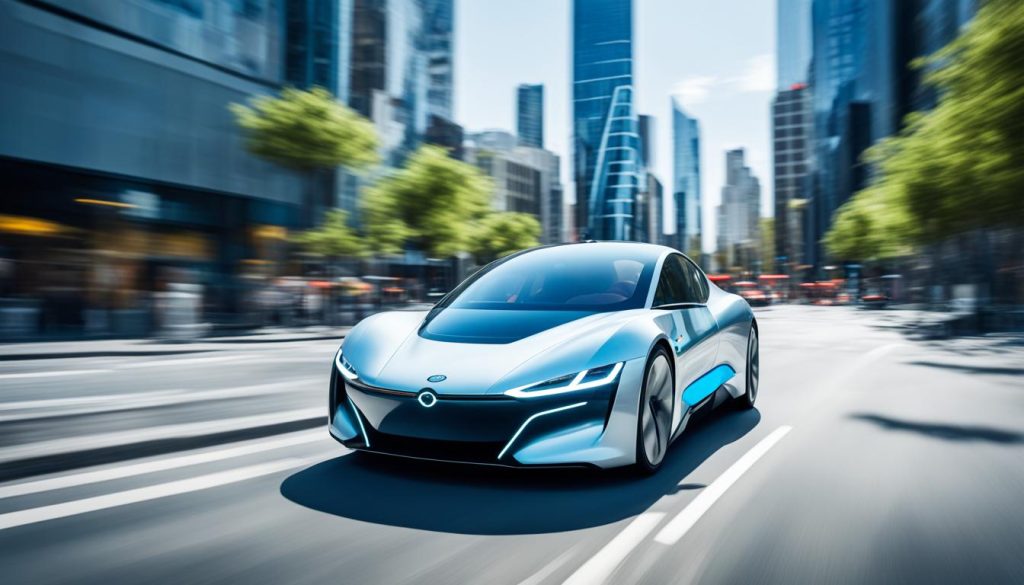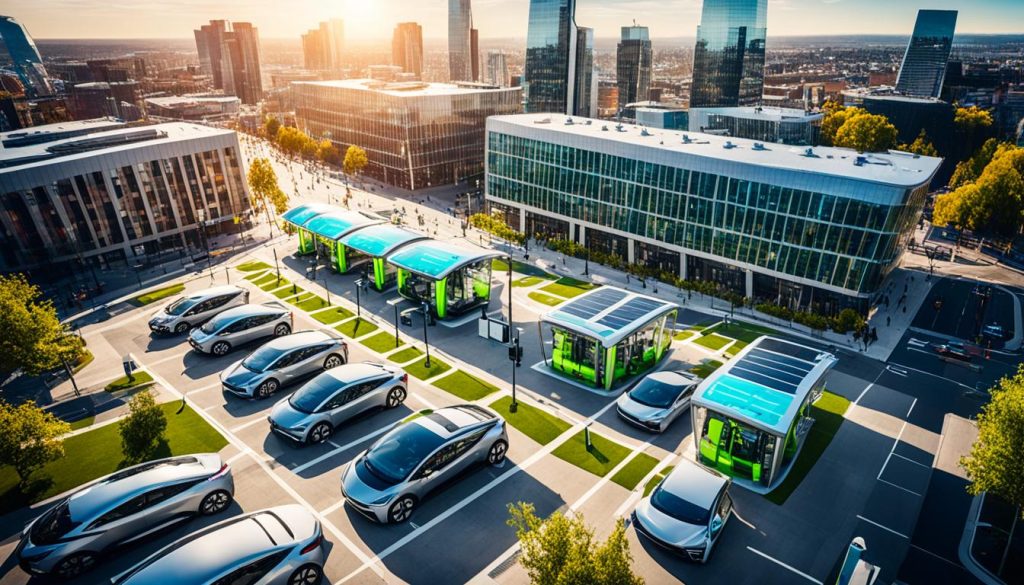Welcome to a journey of sustainable mobility and green transportation infrastructure. As the global automotive industry embraces the shift towards electric vehicles (EVs) and eco-friendly mobility options, the development of robust electric vehicle infrastructure is of paramount importance. This article takes a closer look at the evolving automotive landscape, the role of technology, and the challenges and solutions in building a seamless charging infrastructure.
With the projected growth of the global automobile market, expected to reach around USD 3969.84B by 2030, the time is ripe for embracing sustainable EV charging solutions. As consumer demand for high-end electric vehicle charging amenities thrives, the industry is witnessing a surge in deluxe EV charging infrastructure. From eco-friendly vehicle power solutions to prestigious electric vehicle amenities, the focus is on providing a seamless charging experience that meets the needs of EV owners.
Join us as we explore the transformative shift taking place in the automotive industry. Discover how technology, including AI, big data, and sensor technologies, is driving the future of mobility solutions and revolutionizing the driving experience. We’ll also delve into the top technologies shaping the automotive industry in 2030, from advanced driver assistance systems (ADAS) to voice technologies and digital twin technology.
However, the journey towards widespread EV adoption and development of electric vehicle infrastructure comes with its own set of challenges. From rethinking vehicle architecture to accelerating innovation and ensuring supply chain resilience, manufacturers and industry stakeholders face a range of obstacles in scaling production and infrastructure development.
As we conclude this article, we invite you to embrace the electric vehicle transition and envision a future of predictable and seamless charging. By leveraging data-driven technology and adopting an agile approach, we can shape the future of electric vehicle infrastructure and drive towards a cleaner and greener transportation landscape.
Key Takeaways:
- Electric vehicle infrastructure development is crucial for the widespread adoption of EVs and promoting sustainable transportation solutions.
- The automotive industry is undergoing a transformative shift towards electric propulsion and interconnected mobility.
- Advanced technologies like AI, big data, and sensor technologies are shaping the future of the automotive industry.
- The top technologies shaping the automotive industry in 2030 include ADAS, artificial intelligence, computer vision, and voice technologies.
- Manufacturers and stakeholders need to address challenges related to vehicle architecture, innovation, and supply chain resilience to accelerate infrastructure development.
The Automotive Industry Landscape Shift
The automotive industry is undergoing a significant shift towards hybrid and fully electric vehicles, highlighting a strong commitment to sustainability and eco-friendly mobility options. This transition is driven by the growing need for greener transportation solutions and the desire to reduce carbon emissions. As a result, automakers are investing heavily in research and development to bring efficient and environmentally friendly vehicles to market.
Tesla, a pioneer in the electric vehicle market, has played a crucial role in popularizing electric cars and increasing consumer awareness. However, the landscape is evolving rapidly, with emerging competitors like BYD and Rivian challenging Tesla’s dominance. These companies bring their innovative technologies and unique designs to the electric vehicle market, intensifying the competition and pushing the boundaries of what electric vehicles can achieve.
While the automotive industry witnesses this exciting shift towards sustainable mobility, it faces challenges in establishing a robust charging infrastructure to support the widespread adoption of electric vehicles. To ensure a seamless transition, significant investments are required to build an extensive and reliable network of charging stations. The development of a comprehensive charging infrastructure will be vital in addressing range anxiety and providing the necessary infrastructure for eco-friendly mobility options to thrive.
With the rising demand for electric vehicles and the increasing importance of sustainability, the automotive industry is at a pivotal moment in shaping the future of mobility solutions. As more manufacturers invest in hybrid and fully electric vehicles and the necessary charging infrastructure, we can expect to see a significant transformation in the way we move and interact with transportation.
Competitors in the Electric Vehicle Market
BYD: A leading Chinese electric vehicle manufacturer, known for its diverse range of electric vehicles, including passenger cars, buses, and trucks. The company aims to merge sustainable transportation with advanced technology.
Rivian: An American automotive company specializing in electric adventure vehicles. Rivian’s lineup includes the R1S SUV and R1T pickup truck, offering both versatility and sustainability.
As more players enter the electric vehicle market, there is a growing focus on developing cutting-edge technologies and expanding product offerings. The competition in the industry drives innovation and pushes manufacturers to deliver more sustainable and eco-friendly mobility options.
The Role of Technology in the Automotive Industry
Technology plays a pivotal role in shaping the evolution of the automotive industry. With advanced technologies like AI, big data, computer vision, and sensors, the industry is experiencing significant transformations. These innovations are driving sustainable mobility solutions, improving safety, and enhancing the overall driving experience.
Advancements in Automotive Industry Technology
Artificial Intelligence (AI): AI-powered systems are revolutionizing the automotive industry by enabling autonomous driving capabilities and enhancing vehicle performance. Through machine learning algorithms, AI can analyze vast amounts of data and make real-time decisions, promoting efficiency and safety on the roads.
Big Data: With the proliferation of sensors and connected vehicles, the industry has access to massive amounts of data. This data can be leveraged to gain valuable insights into consumer behavior, vehicle performance, and traffic patterns, enabling automakers and stakeholders to make informed decisions.
Computer Vision: Computer vision technology utilizes cameras and image processing algorithms to perceive and interpret the surroundings. By analyzing visual input, vehicles can detect and identify objects, pedestrians, and road signs in real-time, contributing to advanced driver-assistance systems (ADAS) and autonomous driving capabilities.
Sensors: Various sensor technologies, such as LiDAR, radar, and ultrasonic sensors, enable vehicles to perceive their environment accurately. These sensors provide crucial data for autonomous driving features, collision avoidance systems, and adaptive cruise control, enhancing safety and precision on the road.
Battery Technologies and Sustainable Mobility
The development of electric propulsion systems and innovative battery technologies is driving the shift towards sustainable mobility solutions in the automotive industry. Electric vehicles (EVs) offer reduced carbon emissions, improved energy efficiency, and decreased reliance on fossil fuels.
Battery Electric Vehicles (BEVs): BEVs are powered solely by electric batteries, eliminating the need for internal combustion engines. These vehicles are becoming increasingly popular as major automakers like Tesla, Nissan, and Volkswagen invest heavily in battery technology advancements and charging infrastructure.
Hybrid Electric Vehicles (HEVs): HEVs combine an electric motor with an internal combustion engine, providing increased fuel efficiency and reduced emissions. The integration of battery technology and regenerative braking enables HEVs to recharge their batteries and reduce reliance on conventional fuel sources.
Autonomous Driving and Personalized Experiences
Autonomous driving capabilities are another significant technological advancement in the automotive industry. With AI-driven systems, sensors, and computer vision, vehicles can operate without human intervention, enhancing safety and efficiency on the road.
Autonomous Features: Autonomous driving features offer various levels of automation, from adaptive cruise control to fully autonomous driving. These features rely on advanced technologies like AI, sensors, and computer vision to enable vehicles to sense and respond to their surroundings, making driving safer and more convenient.
Personalized Interfaces and Immersive Entertainment: Technology is transforming the driving experience with personalized interfaces that adapt to driver preferences. From voice-activated controls to intuitive dashboards and infotainment systems, the automotive industry is providing personalized experiences that enhance comfort and convenience. Additionally, immersive entertainment systems offer passengers a range of entertainment options, making journeys more enjoyable.
The Future of Automotive Technology
As technology continues to advance, the automotive industry is poised for further transformations. Continued research and development in AI, big data, sensors, and battery technologies will drive the future of mobility.
Overall, technology is revolutionizing the automotive industry, facilitating the transition to sustainable and innovative solutions. With advancements in AI, big data, computer vision, and sensor technologies, vehicles are becoming safer, more efficient, and personalized for a superior driving experience.
Top Technologies Shaping the Automotive Industry in 2030
In the rapidly evolving automotive industry, technological advancements are playing a crucial role in shaping the future of mobility. Here are some of the top technologies that are set to revolutionize the automotive landscape by 2030:
1. Advanced Driver Assistance Systems (ADAS)
ADAS encompasses a range of technologies that enhance road safety and driver convenience. Features like lane-keeping assist, automatic emergency braking, and adaptive cruise control utilize sensors and artificial intelligence to provide a safer driving experience.
2. Artificial Intelligence (AI)
AI is the driving force behind many automotive innovations. It enables natural language processing, voice recognition, and machine learning that enhance overall vehicle performance and the driving experience. AI is also essential for enabling proactive maintenance and predictive analysis.
3. Computer Vision
Computer vision technology uses cameras and sophisticated algorithms to interpret visual data. By analyzing real-time road conditions and detecting objects, computer vision systems contribute to enhancing safety on the roads and enabling autonomous driving capabilities.
4. Voice Technologies
Voice technologies provide hands-free control and seamless interaction with vehicle systems. Voice recognition systems powered by natural language processing allow drivers to operate various functions, such as making phone calls, adjusting climate controls, and accessing navigation, without distractions.
5. Sensor Technologies
Sensors play a critical role in automotive technology. They enable vehicles to perceive and understand their environment, enhancing safety and performance. From LiDAR sensors for object detection to ultrasonic sensors for parking assistance, sensor technologies are vital for advanced driver assistance and autonomous driving systems.
6. Big Data
Big data is transforming the automotive industry by providing valuable insights for optimizing performance, improving efficiency, and enhancing the overall driving experience. By analyzing vast quantities of vehicle and driver data, manufacturers can make informed decisions and develop innovative solutions.
7. Digital Twin Technology
Digital twin technology creates virtual replicas of physical vehicles, enabling manufacturers to monitor and analyze real-time performance and conduct simulations. Digital twins assist in testing new features, predicting maintenance needs, and optimizing vehicle design, leading to improved efficiency and reliability.

In summary, the automotive industry is witnessing a rapid transformation driven by cutting-edge technologies such as ADAS, AI, computer vision, voice technologies, sensor technologies, big data, and digital twin technology. These advancements are poised to revolutionize road safety, enhance the driving experience, and pave the way for a connected and autonomous future.
The Challenges of Electric Vehicle Infrastructure Development
Electric vehicle adoption is on the rise, driven by the demand for sustainable transportation solutions. However, the development of a robust electric vehicle infrastructure presents several challenges that need to be overcome to accelerate the transition to electric mobility.
Electric Vehicle Charging Barriers
One of the key challenges in EV infrastructure development is the availability and accessibility of electric vehicle charging stations. Limited charging infrastructure can create range anxiety among EV owners and deter potential buyers from making the switch. To encourage widespread adoption, a comprehensive network of fast and reliable charging stations needs to be established, catering to the diverse needs of EV owners.
Vehicle Architecture and Innovation
The shift to electric vehicles requires rethinking vehicle architecture to accommodate advanced battery systems and optimize energy efficiency. Redesigning vehicles to integrate EV-specific components and technologies poses challenges in terms of design, safety considerations, and performance optimization. Furthermore, continuous innovation is necessary to enhance battery technology, increase range, and reduce charging times.
Supply Chain Resilience
The development of electric vehicle infrastructure involves a complex global supply chain. Ensuring supply chain resilience is crucial to overcome potential disruptions and meet the growing demand for EV charging equipment, hardware, and infrastructure components. Collaborations and partnerships across industries can help streamline the supply chain and mitigate risks associated with raw material sourcing, manufacturing, and distribution.
Manufacturing Scalability
Manufacturing electric vehicles and infrastructure components at scale is essential to meet the increasing demand. Establishing scalable manufacturing processes involves the implementation of advanced technologies, automation, and flexibility in production lines. Forming strategic alliances with suppliers and leveraging their expertise can aid in the rapid scale-up of manufacturing capabilities.
Moreover, customizing production processes to accommodate regional variations in charging standards and infrastructure requirements can further support the growth of electric vehicle infrastructure.
EV Infrastructure Development
Developing electric vehicle infrastructure requires comprehensive planning, investment, and collaboration between various stakeholders, including government agencies, automakers, utilities, and technology companies. Coordinated efforts are needed to identify suitable locations for charging stations, integrate renewable energy sources into the grid, and optimize the charging ecosystem for a seamless user experience.
By addressing these challenges, the transition to a sustainable automotive industry can gain momentum, overcoming barriers and creating a future where electric vehicles are the norm.

Conclusion
The automotive industry is experiencing a revolutionary shift towards electric vehicles, and the development of robust charging infrastructure is critical to fuel this transition. By harnessing the power of data-driven technology, manufacturers can optimize precision, automation, and quality in their manufacturing processes. This approach not only ensures predictable charging experiences for electric vehicle owners but also enables a seamless and efficient overall charging ecosystem.
Embracing innovative technologies and leveraging data insights will shape the future of electric vehicle infrastructure development. Data-driven technology enables manufacturers to leverage real-time information and analytics to optimize charging efficiency, identify potential issues, and deliver exceptional user experiences. By continuously monitoring and analyzing charging patterns and behavior, manufacturers can provide tailored recommendations and personalized solutions, enhancing the overall EV charging experience.
Predictable charging experiences are crucial for the widespread adoption and acceptance of electric vehicles. Data-driven technology allows for intelligent charging management, capacity planning, and optimization, ensuring that resources are efficiently utilized. This results in reduced charging times, reduced stress for vehicle owners, and optimized utilization of charging infrastructure—empowering a seamless and reliable charging process for electric vehicle users.
FAQ
What is the importance of electric vehicle infrastructure?
What are sustainable EV charging solutions?
How does electric vehicle infrastructure support green transportation?
What are high-end electric vehicle charging amenities?
How do eco-friendly vehicle power solutions contribute to the automotive industry?
What are deluxe EV charging infrastructure facilities?
How can the automotive industry ensure a seamless transition to electric vehicles?
Source Links
- https://hexagon.com/go/mi/drive-digital-transformation-in-automotive
- https://www.linkedin.com/pulse/driving-future-technologies-transforming-automotive-industry-ashok-0f1lc?trk=public_post
- https://www.linkedin.com/posts/andrew-cornelia-44b8403b_evchargingwest-mercedesbenz-evcharging-activity-7160367372745232385-BQTy
